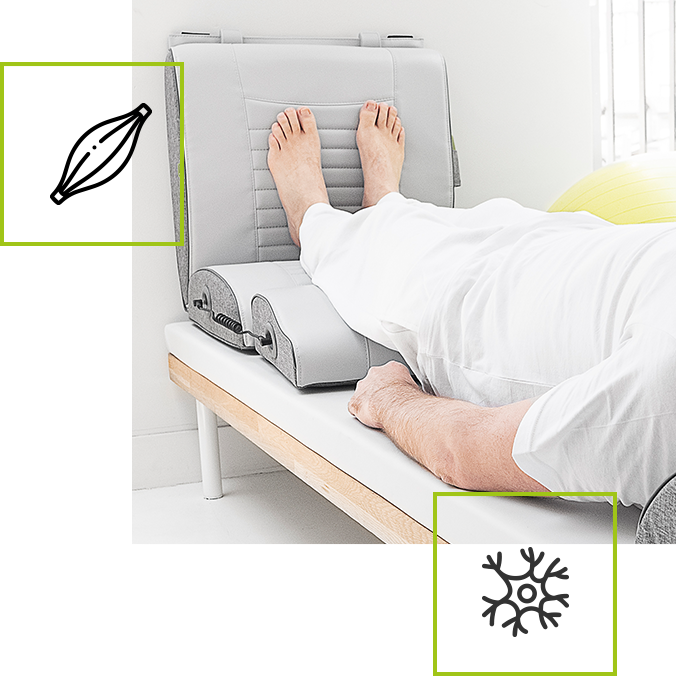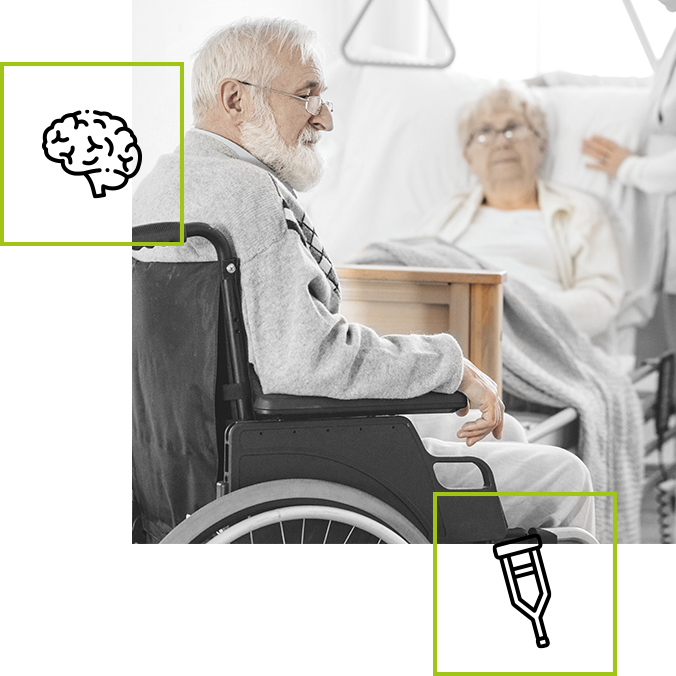Vibrotherapy - supports the treatment of spasticity
Vibrotherapy treatments reduce spasticity levels and increase ranges of movement and motor capacity.
How does it work?
Studies indicate that the application of low-frequency vibratory stimuli to paralysed muscles reduces the symptoms of spasticity by reducing excessive excitability of motor neurons.


When and for whom?
Vibrotherapy is recommended for patients with muscle spasticity resulting from diseases of the central nervous system.
Effectiveness
Vibration applied (just once and for just five minutes) to post-stroke patients significantly reduced excessive excitability of motor neurons, attenuating spasticity symptoms and improving volitional (voluntary) movements of the spastic limb.

Yen CL, McHenry CL, Petrie MA, Dudley-Javoroski S, Shields RK. Vibration training after chronic spinal cord injury: Evidence for persistent segmental plasticity. Neurosci Lett. 2017 Apr 24;647:129-132. doi: 10.1016/j.neulet.2017.03.019. Epub 2017 Mar 16. PMID: 28315725; PMCID: PMC5518623.
Benefits of vibrotherapy

No side effects

Action confirmed by scientists and practitioners

Perceptible effects from 1 treatment

Long-lasting effects through systematic use
Choose the right product
We will help you select a set of modules that suits your conditions.
Spasticity
An involuntary, increased neuromuscular activity accompanying damage to the motor neurons of the brain with their descending pathways to the muscles.Spasticity is a neurological symptom characterised by increased muscle tone. It is the result of abnormalities in the nervous system, particularly in the regulation of motor functions by the brain and spinal cord. Spasticity can occur as a result of a variety of neurological conditions, such as post-traumatic brain injury, stroke, multiple sclerosis, cerebral palsy or other neurological diseases.
The main features of spasticity include:
- Increased muscle tone: People with spasticity experience increased resistance when trying to move a particular limb or muscle. The muscles become stiff and difficult to control.
- Movement disorders: Spasticity can lead to difficulty controlling movement, which can significantly affect the ability to perform everyday activities such as walking, holding objects or maintaining balance.
- Clonic reflexes: Clonic reflexes, which are rapid, rhythmic muscle contractions that can be difficult to control, may occur.
- Muscle contractions: Uncontrolled muscle contractions may occur as a result of spasticity, which can lead to painful contractions.
Vibrotherapy in the fight against spasticity
Vibrotherapy, which is therapy using vibration or vibration, can be used as one of the techniques to help treat spasticity. It will help to relax the tense muscles characteristic of spasticity by stimulating nerve receptors and reducing muscle tension. In addition, vibrotherapy can help to increase muscle flexibility, facilitating movement and reducing muscle resistance.
Vibrotherapy-induced vibrations also have a positive effect on blood circulation, which contributes to healthy tissue nutrition and elimination of metabolic products. Stimulation of the nervous system, including proprioception and muscle reflexes, is another aspect that can be regulated by vibration, positively influencing motor control.
Vibrotherapy can also have an analgesic effect, reducing pain by reducing muscle tension and improving blood flow. As part of a rehabilitation programme, it can be used to improve range of motion, motor coordination and overall muscle function in people with spasticity. In addition, the relaxing effect of vibration can provide relief for people who experience frequent muscle tension.
Effects of spasticity
Prolonged spasticity causes, among other things, muscle shortening, joint deformity and reduced range of movement and mobility.
Treatment consists mainly of botulinum toxin, muscle stretching, thermo- and electrotherapy and, more recently, vibrotherapy: local or whole-body.
The treatment of spasticity can include different strategies, depending on its cause and severity. Among the treatments that can be used are:
- Medication: anti-spasticity drugs can help relieve symptoms by reducing muscle tension.
- Physiotherapy: Physiotherapy exercises can help maintain muscle flexibility, improve muscle strength and motor coordination.
- Occupational therapy: It can help improve motor skills and facilitate daily activities.
- Botulinum injections: In some cases, botulinum toxin injections are used to weaken excessively contracted muscles.
- Surgery: In extreme cases, especially when spasticity leads to significant movement limitations and functional problems, surgical intervention may be considered.






